Mountain hare
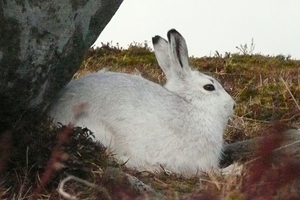 The mountain hare is sometimes known as the ‘blue hare’ because of its blue-grey summer coat, in contrast to the rich brown fur of the brown hare. The mountain hare turns white in winter, helping it match its snowy surroundings as it lives high in the mountains of Scotland.
The mountain hare is sometimes known as the ‘blue hare’ because of its blue-grey summer coat, in contrast to the rich brown fur of the brown hare. The mountain hare turns white in winter, helping it match its snowy surroundings as it lives high in the mountains of Scotland.
The mountain hare is smaller than the brown hare, having a body length of around 50-60cm, with a more rounded shape. Mountain hares also have shorter ears and legs than the brown hare, although both types of hare have much longer ears and hind legs than rabbits, which are sometimes confused with hares.
Brown hare
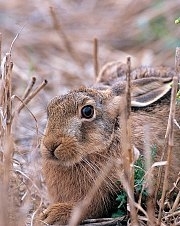 Brown hare live in the fields, on farms, in the higher heathlands, moorlands, wetlands and woodlands. They do not dig underground like rabbits; they shelter in scrapes. Much bigger than rabbits, brown hare have big, long and strong back legs and long ears, which stand up more. They also move in a different way.
Brown hare live in the fields, on farms, in the higher heathlands, moorlands, wetlands and woodlands. They do not dig underground like rabbits; they shelter in scrapes. Much bigger than rabbits, brown hare have big, long and strong back legs and long ears, which stand up more. They also move in a different way.
Brown hares are known for their boxing, seen in the spring. This is not, as once thought, males fighting but more likely to be females fending off unwanted attention from the males. Females, known as jills, will produce three litters a year of 2-4 leverets, which are born with fur and able to see.
Photo credit: Alexis de la Serre
Rabbit
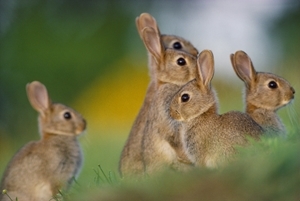 Rabbits were originally brought to Britain by the Normans in the 12th Century. They were bred for their meat and fur. Of course, there were numerous escapees and by the 18th Century they had escaped and bred so successfully that they had become a major pest. The population continued to grow, with numbers probably peaking in the mid-1900s at about 100 million, causing an estimated £1 million worth of damage, which was a lot of money in those days.
Rabbits were originally brought to Britain by the Normans in the 12th Century. They were bred for their meat and fur. Of course, there were numerous escapees and by the 18th Century they had escaped and bred so successfully that they had become a major pest. The population continued to grow, with numbers probably peaking in the mid-1900s at about 100 million, causing an estimated £1 million worth of damage, which was a lot of money in those days.
In 1953 with the introduction of the virus myxomatosis, 99% of the population had died. The resilient rabbit has come back from the brink, though, and estimates now suggest there are 40 million nationwide. If conditions allow, rabbits will breed throughout the year and can produce a litter of 3-7 young (known as kittens) per month. The female (doe) constructs a nest inside a burrow from grass bedding and lines it with soft fur from her chest and belly. The young kittens are born blind, deaf and almost hairless.
Photo credit: Laurie Campbell
Stoat
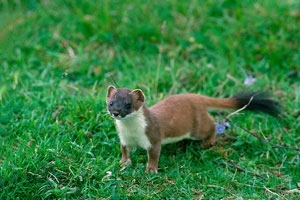 Stoats have a long, slim body with relatively short legs and a tail that always has a black tip. Even when some of the more northerly-based stoats change their coat colour from a reddish brown to white or partial white in winter (known as ‘ermine’), they still hang on to the black-tipped tail. The collective noun for stoats is ‘caravan’, although ‘pack’ and ‘gang’ are also used.
Stoats have a long, slim body with relatively short legs and a tail that always has a black tip. Even when some of the more northerly-based stoats change their coat colour from a reddish brown to white or partial white in winter (known as ‘ermine’), they still hang on to the black-tipped tail. The collective noun for stoats is ‘caravan’, although ‘pack’ and ‘gang’ are also used.
After mating, the female is able to delay the implantation of the fertilised eggs for some nine to ten months, meaning she technically carries the offspring for nearly a year. The actual gestation period, though, is only four weeks long! She will give birth to 6-12 blind, deaf, toothless kits, their bodies covered in a fine white down, huddled together in a fur-lined nest. The stoat is a fantastically skilful predator that can climb trees to raid bird nests, squeeze down and through all sorts of holes and entrances to look for small mammals, and has endless amounts of stamina to chase larger prey. Their eyesight is, however, not quite as good as ours (though better than human sight in the dark), so scent plays an important role when pursuing a victim.
Weasel
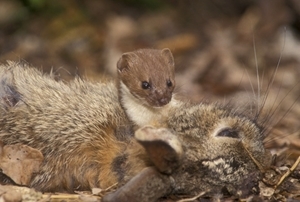 The weasel is Britain’s smallest native carnivore, much smaller than stoats, and they don’t have a black tip on the end of their tails. A weasel is weaselly recognised and a stoat is stoatally different! They have long and slender bodies with a short tail. They feed mainly on small rodents, birds, eggs and chicks, from high on the hill to the lowlands and all those in between.
The weasel is Britain’s smallest native carnivore, much smaller than stoats, and they don’t have a black tip on the end of their tails. A weasel is weaselly recognised and a stoat is stoatally different! They have long and slender bodies with a short tail. They feed mainly on small rodents, birds, eggs and chicks, from high on the hill to the lowlands and all those in between.
Photo credit: David Mason
Pine marten
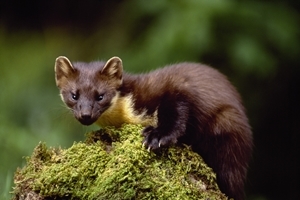 Most frequently found in coniferous forest, they are seldom seen out in the open. Pine martens come from the mustelid family, as do weasels, stoat, ferrets, badgers and otters. They have a rich, chestnut-brown body colour, with a characteristic pale yellow ‘bib’ on their chin and throat, and support a long, bushy tail. They have rounded ears, relatively short legs (certainly in comparison to their long bodies) and are about the size of a smallish cat. They can potentially live for about 8-10 years. Pine martens have territories varying in size from 5-25 square kilometres.
Most frequently found in coniferous forest, they are seldom seen out in the open. Pine martens come from the mustelid family, as do weasels, stoat, ferrets, badgers and otters. They have a rich, chestnut-brown body colour, with a characteristic pale yellow ‘bib’ on their chin and throat, and support a long, bushy tail. They have rounded ears, relatively short legs (certainly in comparison to their long bodies) and are about the size of a smallish cat. They can potentially live for about 8-10 years. Pine martens have territories varying in size from 5-25 square kilometres.
Young pine martens, which are known as kits, are born during March and April. Typically, two to three kits will be born, each weighing less than 30g. The kits stay in the den for about six weeks and are totally dependent on the female. Kits will then start exploring the area around the den and will stay with their mother for at least six months. Pine martens are extremely agile and great climbers, helped by their long tail, which they use constantly for balance.
They have a wide and varied diet, which is chiefly carnivorous, catching birds; amphibians; mammals such as rodents, rabbits and grey squirrel; and, during winter months, they will also feed on carrion. They have a great liking for eggs and baby birds, but will also eat fungi, fruit and berries. In fact, in Scotland, bilberries can make up to 30% of a pine marten’s summer diet, resulting in its droppings turning blue in colour!
Photo credit: Laurie Campbell
Roe deer
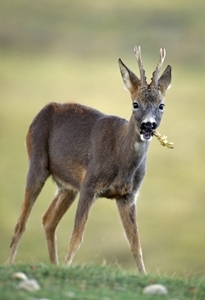 A beautiful orange brown colour, the roe deer can be seen roaming woodlands, scrub and grasslands across the country. They are quiet and shy animals so will run at unfamiliar sounds, but watch how they move as they have a lovely bounding movement as they go.
A beautiful orange brown colour, the roe deer can be seen roaming woodlands, scrub and grasslands across the country. They are quiet and shy animals so will run at unfamiliar sounds, but watch how they move as they have a lovely bounding movement as they go.
During the summer months when food is in abundance and the roe are in their peak condition it is also the mating season. However, the female roe deer or ‘doe’ holds the fertilised egg for five months floating in the womb, allowing them to make the most of the lush grass and food supplies to help them through the cold winter months. Only at the end of the year will the embryo start to grow and attach to the wall of the uterus, creating a normal pregnancy. Roe deer usually give birth to twins, sometimes triplets, and so the demands on the doe would be great if she had to sustain these throughout the winter. When the young are born towards the end of May and into June, the weather is kind and the vegetation is high, creating plenty of cover for the newly born deer to hide away from the prying eyes of predators.
Photo credit: Laurie Campbell
Otter
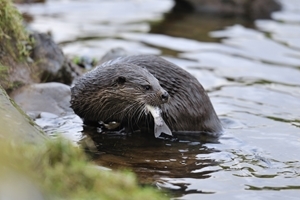 Otters are related to badgers, pine marten, polecats, ferrets, stoat and weasels – they are all part of the mustelid family. Otters live in and around water; they eat fish, eel, frogs, some birds, and those that live on the coast will also eat crabs. They will eat approximately 1.5kg of food a day. Male otters weigh around 8kg while females are slightly lighter at 6kg. They can live for ten years but normally manage around five. Females will choose quiet, undisturbed tributaries to have their cubs, also known as ‘kits’. They will have two or three at a time, and these young stay with mum for the first year before being completely independent.
Otters are related to badgers, pine marten, polecats, ferrets, stoat and weasels – they are all part of the mustelid family. Otters live in and around water; they eat fish, eel, frogs, some birds, and those that live on the coast will also eat crabs. They will eat approximately 1.5kg of food a day. Male otters weigh around 8kg while females are slightly lighter at 6kg. They can live for ten years but normally manage around five. Females will choose quiet, undisturbed tributaries to have their cubs, also known as ‘kits’. They will have two or three at a time, and these young stay with mum for the first year before being completely independent.
Photo credit: Laurie Campbell
Fox
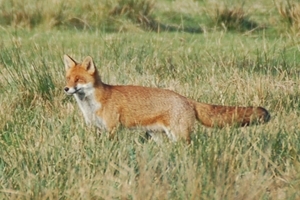 Foxes live in grasslands, heathlands, moorland, farmland, woodland, towns and gardens. Foxes are at the top of the food chain; there is no other creature hunting them. They are omnivores so eat both meat and plants, with the fox’s diet consisting of small birds, frogs, worms and carrion as well as berries and fruit. A fox can see quite well and has excellent hearing, but its world revolves around scent. Just a tiny whiff of scent will draw the fox in for its next snack. A fox will mark its territorial boundaries with urine, faeces and scent glands, which are located on the tail, face, foot pads and bottom, all combining to send messages to other foxes in the area. A range of barks, yaps and shrieks are also used to communicate.
Foxes live in grasslands, heathlands, moorland, farmland, woodland, towns and gardens. Foxes are at the top of the food chain; there is no other creature hunting them. They are omnivores so eat both meat and plants, with the fox’s diet consisting of small birds, frogs, worms and carrion as well as berries and fruit. A fox can see quite well and has excellent hearing, but its world revolves around scent. Just a tiny whiff of scent will draw the fox in for its next snack. A fox will mark its territorial boundaries with urine, faeces and scent glands, which are located on the tail, face, foot pads and bottom, all combining to send messages to other foxes in the area. A range of barks, yaps and shrieks are also used to communicate.
Female foxes (vixens) will breed just once a year, when they find a den or ‘earth’ and give birth to four or five young in the spring. Fox cubs are born blind, have round faces and short ears, and are covered with dark, chocolate brown fur.